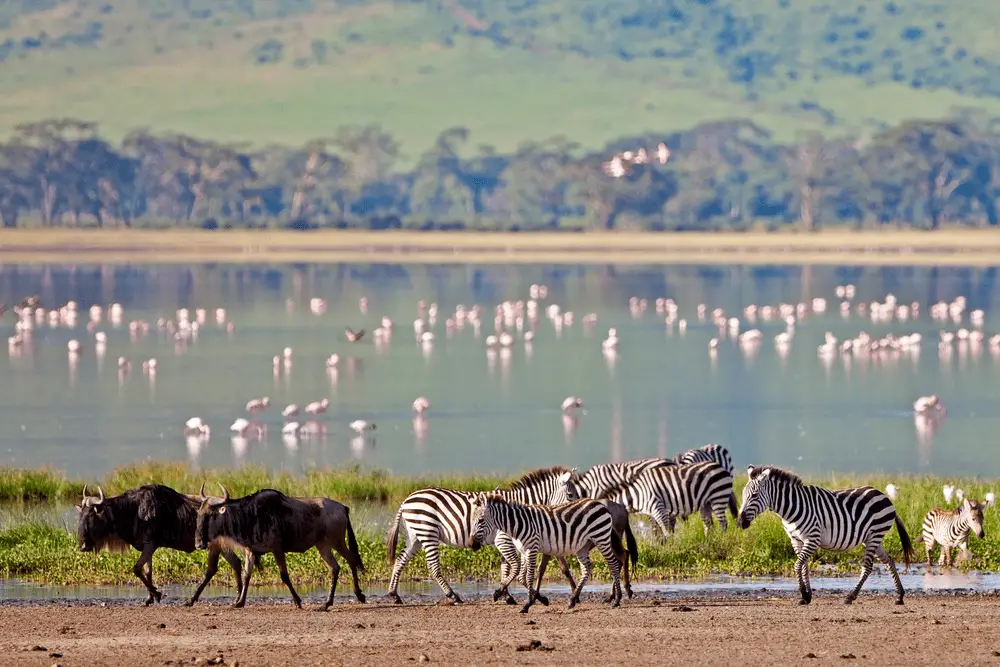Table of Contents
*This post may contain affiliate links. As an Amazon Associate we earn from qualifying purchases.
Are you looking for a once-in-a-lifetime experience? Do you want vacation that is also an adventure? Have you always dreamed of going on safari, and seeing giraffes, lions and elephants in their natural habitat? Then you need to take a visit to the Ngorongoro Crater!
While the nearby Serengeti National Park is more well known, the Ngorongoro Conservation Area offers an experience unlike any other. If you are planning a trip to Africa, this should be on the top of your list of attractions. If you go through your entire life without seeing this incredible wonder of the world, you will sorely regret it. You will not such a quantity and diversity of wildlife anywhere else.
What Is the Ngorongoro Crater?
The Ngorongoro Crater is the largest intact caldera in the world that isn’t filled with water. A caldera is created when a volcano has such a ferocious eruption that it caves in on itself, leaving a crater. The eruption that caused this particular crater is estimated to have occurred three million years ago, when what was likely the tallest mountain on the continent violently erupted and then collapsed in on itself. This left an indentation about 12 miles wide and 2,000 feet deep.
Over the next couple million years, this indentation slowly began filling with life. First plants began growing, which then attracted grazing animals, which in turn attracted predators. Today, it is one of the most biodiverse places on the planet. As one of the Seven Natural Wonders of Africa and one of the Ten Natural Wonders of the World, it attracts a half million tourists a year from every continent.
Although the area feels like a pristine paradise untouched by humans, the truth is that humans have been coexisting with wildlife there for millennia. There are human footprints and fossils dating back three million years or more, some of which can be seen in the nearby museum. It is currently home to a semi-nomadic pastoral tribe known as the Maasai, who still practice their traditional method of livestock grazing.
Where Is the Ngorongoro Crater?
The crater is in the Ngorongoro Conservation Area in northern Tanzania. The park spreads from the east end of the Great Rift Valley to the plains of the Serengeti National Park. In addition to the crater, the Ngorongoro Conservation Area consists of vast plains, savannahs, and forests, and is also home to a long, deep ravine known as the Olduvai Gorge.
The Conservation Area was established as a multi-use area in 1959. It is a globally important area for biodiversity due to the density of wildlife in the area, including threatened species. Because of this, it was protected as a UNESCO World Heritage Site twenty years later, in 1979.
Wildlife
Biodiversity
The Ngorongoro crater has been nicknamed the “Garden of Eden” because of its lush beauty and rich biodiversity. Estimates of the number of wild creatures living in the crater range from 25,000 to 40,000. Some of the species that call the crater home include wildebeest, elephants, cheetahs, lions, rhinoceros, hyenas, and gazelles. It has one of the highest concentrations of wildlife in the world.
There are also over 500 bird species that can be found in the crater, including ostriches, secretary birds, kori bustards, and pink flamingos. If you’re a bird watcher, November through April are the best time to catch glimpses of the numerous migratory birds.
Migratory Animals
The Ngorongoro Crater is an important part of the migratory path of not only birds, but mammals as well. The Great Wildebeest Migration passes through the area every year from about December to March. This is the largest ungulate migration in the world, with over two million wildebeest, gazelles, and zebras.
The Big 5 Mammals of Africa
The Ngorongoro Crater is one of the only places in the world where you can find all five of what are known as the Big 5 Mammals of Africa: buffalos, elephants, lions, leopards and rhinoceros. The crater has the highest density of lions in the world and is the best place to catch a glimpse of the extremely rare black rhino.
Endangered Species
The Crater is home to many globally threatened species, including the aforementioned black rhino. There are about 20 or 30 of these nearly extinct rhinos living in the park. As a conservation area, endangered species are protected here from human interference.
Visiting
When to Visit
The best time to visit the Ngorongoro Crater depends on what you are hoping to see. Are you more of a bird watcher, or are you interested in seeing the massive mammal migration? It is recommended to avoid it during the rainy season, as the roads can become slippery and impassible, and many of the animals will be hiding in shelter. The dry months are usually June to September and December to February.
Safaris
By far the most popular activity for visitors to the Ngorongoro Crater is safaris. Indeed, it is quite a popular destination for vacations and honeymoon safaris. Nowhere else in the world will you be able to see such a dense concentration of wild animals, and it draws hundreds of thousands of tourists per year.
Not surprisingly, there is a booming industry in safari tour companies. Safari packages can run from two to five days, with the details of the trip planned from beginning to end. Because of this, it will take some research to decide which is the best safari package for you.
Many tour operators offer safari packages that include accommodation and transportation as well as meals and all park entry fees. This all-inclusive packages make planning your safari trip easy, as you just pay the tour company and they handle the rest. Make sure the company you go with is reputable, and book well in advance. The safari tours are extremely popular and do fill up.
Accommodations
With so many tourists visiting over the year, a number of accommodation businesses have sprung up. You have your choice of budget lodges, midrange lodges, and luxury hotels. These can be found throughout the park, but the best ones face the crater, giving a fantastic view. That’s right, you can sleep on the rim of the caldera itself and potentially wake up to giraffes or elephants right at your doorstep!
Park Fees
Keep in mind that if you are not using an all-inclusive package from one of the tour companies, you will have to pay the park fees yourself, which can be quite steep. The park is managed by the Ngorongoro Conservation Authority, and the fees go to maintaining the park and to the development of the surrounding communities. All parks and conservation areas in Tanzania are subject to these fees.
The fees for visiting the Ngorongoro Crater currently run about $70 for adults and $25 for children 15 and under. These are just the fees for visiting the park or passing through it on the way to Serengeti National Park. If you want to be able to actually descend into the crater itself, there is an additional $295 fee per car. The fees are valid for 24 continuous hours inside the park, but they expire as soon as you leave.
It is a rule in all Tanzania parks and conservation areas that no cash is accepted at the gate. You can pay with a credit card, but this may incur additional processing fees in addition to charges from your bank. You can also go into a local bank to pay your park entrance fees. They will give you a receipt to keep with you that you can then present at the gate.
Self-Driving
Because of the fees, many people prefer to use tour companies rather than self-drive in the park. In addition, it is easier to explore with an experienced driver who knows the area and the rules regarding self-driving. However, if you are the adventurous type, you can rent your own vehicle and drive around the park yourself, enjoying the sights. If you intend on driving into the crater itself, it is imperative to have a 4WD vehicle in good mechanical condition, or you will not be able to make the steep climb back out.
Camping
Yes, there is an option to camp inside the park, although there are additional fees for doing so. There are designated campgrounds, and it is not permissible to camp anywhere else. This is a delicate conservation area, and the primary reason for its existence is preserving the animal species, not human enjoyment. You can camp there on your own or as part of a safari tour group.
Conclusion
If you are looking for the wildest vacation of your life—in more ways than one—look no further than the Ngorongoro Crater. A safari in the majestic park will be unlike anything you have ever seen. It’s like being transported to another world, or to a time in our planet’s primordial past. You’ll be telling the stories of what you see and experience to your friends and family members for many years to come.

